Home Remedies For Knee Pain: 14 Pantry Ingredients That Work
Ease the stress on your knees with the help of the finest kitchen ingredients.

Image: Shutterstock
Be it from falling often, injury, or a serious medical condition such as arthritis, knee joint pain can be debilitating and can put your body through a lot of stress. If you are looking to ditch those painkillers and opt for some natural alternatives, you have come to the right place. In this article, we explore the causes and the top 14 ingredients from your pantry that can soothe your knee pain effectively and naturally. Scroll down to check them out!

In This Article
What Causes Knee Joint Pain?
Knee joint pain is never really a result of a single cause. While temporary knee pain, which is caused by an injury, usually fades away on its own, that on and off pain in your knee could be due to certain underlying causes that need to be treated. If the pain is due to an injury, physical therapy and plenty of rest are the best medicines for you.
Physical conditions or diseases that are responsible for chronic knee pain are:
- Osteoarthritis of the knee joint that may cause pain, swelling, and inflammation.
- Tendinitis – Pain in the front of the knee that makes physical movements like climbing the stairs painful.
- Bursitis – Inflammation of the knee joint caused by repeated overuse or injury of the knee.
- Chondromalacia patella – Damage to the cartilage under the kneecap.
- Gout – Elevated levels of uric acid in the body that results in arthritis.
- Baker’s cyst – Build-up of synovial fluid right behind the knee.
- Rheumatoid arthritis – An autoimmune disorder that causes pain and swelling in the affected joint, often leading to the erosion of the bone.
- Meniscus tear – A rupture of one or multiple cartilages of the knee.
- Torn ligament – A tear in any one of the four knee ligaments.
- Bone tumors that develop near the knee.
No matter what the cause of your constant knee pain is, the following remedies can offer relief to a great extent. These natural remedies cause you no harm and might provide you relief without depending on medications.
Key Takeaways
- Use an ice pack on the affected area to soothe the pain and reduce the swelling.
- You can massage the knee with olive oil. It will reduce discomfort with its anti-inflammatory properties.
- Swimming and cycling can increase knee mobility and reduce pain.
- You can keep a hot water bottle on top of the knee to increase the blood flow in that area.
How To Treat Knee Joint Pain Naturally
- Apple Cider Vinegar
- Ginger
- Turmeric
- Cayenne Pepper
- Lemon
- Olive Oil
- Coconut Oil
- Fenugreek Seeds
- Dandelion Leaves
- Mustard Oil
- Essential Oils
- Epsom Salt Soaks
- Hot And Cold Packs
- Vitamins
Home Remedies To Reduce Knee Joint Pain
1. Apple Cider Vinegar
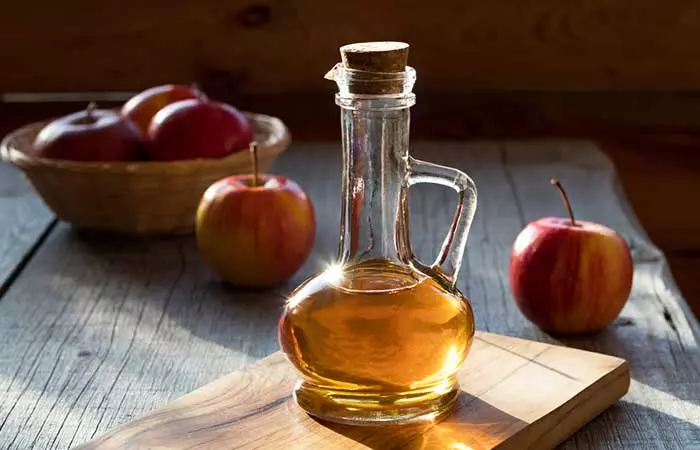
You Will Need
- 2 teaspoons of apple cider vinegar
- 1 glass of warm water
What You Have To Do
- Add two teaspoons of apple cider vinegar to a glass of water and mix well.
- Consume this solution daily, preferably before meals.
- You can also mix two tablespoons of apple cider vinegar with a tablespoon of coconut oil and apply it to the affected knee.
How Often You Should Do This
You must do this twice daily.
Why This Works
Apple cider vinegar, whether it is consumed or applied topically, helps combat knee joint pain. It is a great home remedy for body pain in general.
It contains acetic acid that exhibits anti-inflammatory properties, which help reduce the pain and swelling in the affected area (1).
2. Ginger
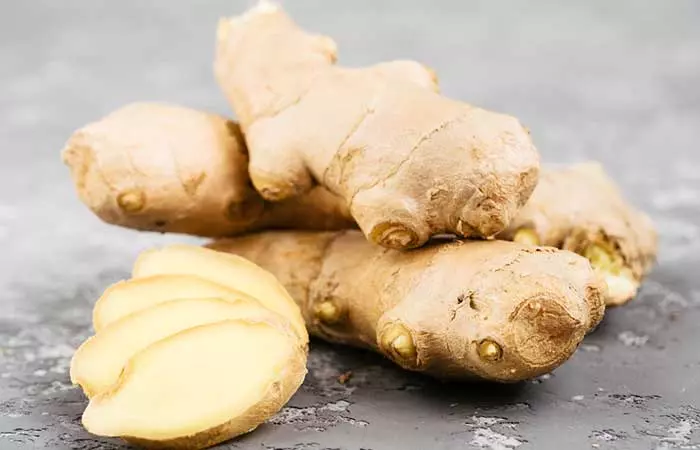
You Will Need
- 1-inch piece of ginger
- 1 cup of water
- Gauze or a clean washcloth
What You Have To Do
- Add an inch of ginger to a cup of water.
- Bring it to a boil and simmer for 5 minutes.
- Strain and allow the solution to cool for a while.
- Dip a clean washcloth or gauze in the warm ginger water and place it on the affected area.
- Wrap the soaked cloth around your knee and allow it to work.
- You can also consume ginger tea daily.
How Often You Should Do This
Do this several times daily for best results.
Why This Works
Ginger was found to help individuals suffering from knee pain due to osteoarthritis
(2). The presence of compounds like gingerol makes it a powerful anti-inflammatory and analgesici A type of over-the-counter drug specifically formulated to reduce or relieve pain without loss of consciousness. remedy (3).
 Quick Tip
Quick Tip3. Turmeric

You Will Need
- 1 teaspoon of turmeric
- 1 glass of coconut or almond milk
What You Have To Do
- Add a teaspoon of turmeric to a glass of hot milk and mix well.
- Consume the mixture.
- You can also make a paste of turmeric and apply it to the affected area.
How Often You Should Do This
Do this twice daily.
Why This Works
Curcumin, the major component of turmeric, is a powerful anti-inflammatory compound. It was found to alleviate symptoms of joint pain and inflammation in multiple studies owing to its anti-inflammatory properties (4), (5).
A study was conducted on 1810 adults with knee osteoarthritis (OA) in order to assess the efficacy of turmeric extracts for managing the condition. It was concluded that turmeric extracts did reduce knee pain by 86.23% and improved physical mobility by 90.05%. When compared with placebo and other active comparators, turmeric showed 12% lesser adversities.
4. Cayenne Pepper

You Will Need
- 3 tablespoons of cayenne pepper
- 1 cup of olive oil
- ½ cup of grated beeswax
- A double boiler
- A lidded glass jar
What You Have To Do
- Add three tablespoons of cayenne pepper to a cup of olive oil.
- Heat in a double boiler for about 10 minutes on medium heat.
- Add half a cup of grated beeswax to this while stirring continuously.
- Continue stirring until the mixture is smooth, and the beeswax has dissolved completely.
- Refrigerate the mixture for 10 minutes, after which you have to whisk it again.
- Chill for 15 minutes and whisk the mixture once more.
- Transfer the balm to a glass jar with a lid and refrigerate.
- Use the mixture as and when required.
- This mixture can be used for up to one and a half weeks.
How Often You Should Do This
You must apply this mixture to the affected area multiple times daily.
Why This Works
Cayenne pepper is an excellent remedy for treating knee joint pain as it contains capsaicin.
Capsaicin acts as a natural pain reliever due to its anti-inflammatory and analgesic activities (6).
5. Lemon

You Will Need
- 1 lemon
- 1 tablespoon of sesame oil
What You Have To Do
- Extract the juice of a lemon.
- Mix it with a tablespoon of sesame oil.
- Apply this mixture topically to the affected knee.
- Leave it on for about 30 to 40 minutes.
- Repeat as required.
- You can also consume lemon juice daily for faster recovery.
How Often You Should Do This
You must do this 3 to 4 times daily.
Why This Works
Lemons have anti-inflammatory properties that help reduce the inflammation, pain, and swelling that accompany knee pain
(7).
6. Olive Oil

You Will Need
Extra virgin olive oil (as required)
What You Have To Do
- Take some olive oil in your palms and massage it into the affected knee.
- Leave it on and allow it to evaporate naturally.
- If you are uncomfortable with the stickiness, you can leave the oil on for about 30 minutes and then wash it off.
How Often You Should Do This
Do this 3 to 4 times daily for effective results.
Why This Works
The active constituents of olive oil include biologically active polyphenols like hydroxytyrosol, tyrosol, oleocanthal, and oleuropein. All these compounds have powerful anti-inflammatory properties that work wonderfully in treating knee joint pain (8).
7. Coconut Oil

You Will Need
Extra virgin coconut oil (as required)
What You Have To Do
- Take some extra virgin coconut oil and apply it directly to the affected area.
- You can allow it to dry on its own or rinse it off after 30 minutes.
How Often You Should Do This
Do this several times in a day.
Why This Works
Coconut oil can help reduce the inflammation and pain associated with knee joint pain with its anti-inflammatory and analgesic activities (9).
8. Fenugreek Seeds

You Will Need
- 2 teaspoons of fenugreek seeds
- 1 glass of water
What You Have To Do
- Add two teaspoons of fenugreek seeds to a glass of water. Soak overnight.
- Strain and consume the water.
- You can also blend the soaked fenugreek seeds and apply the paste on the affected knee.
How Often You Should Do This
You must do this daily.
Why This Works
Fenugreek seeds possess anti-inflammatory and analgesic properties that work wonders in treating the pain and inflammation associated with knee joint pain (10).
9. Dandelion Leaves
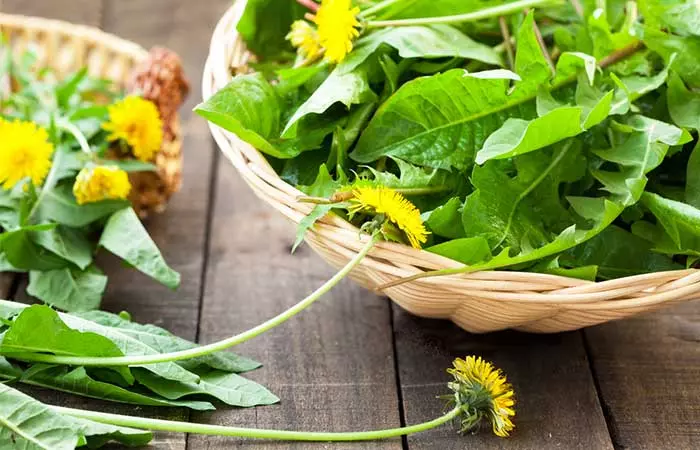
You Will Need
- 10-12 dandelion leaves
- 1 cup of water
- Honey
What You Have To Do
- Wash the dandelion leaves thoroughly.
- Bring them to a boil in a saucepan. Simmer for 5 minutes and strain.
- Allow it to cool.
- Add a little honey to it and consume immediately.
- You can also add dandelion leaves to your favorite juice or smoothie.
How Often You Should Do This
You must consume dandelion leaves 1 to 2 times daily for best results.
Why This Works
Regular consumption of dandelion leaves can help relieve knee pain to a great extent, and this is due to their powerful anti-inflammatory properties (11).
10. Mustard Oil

You Will Need
Mustard oil (as required)
What You Have To Do
- Take some mustard oil in your palms and massage it directly onto the affected knee.
- Repeat as necessary.
- You can also add a clove of chopped garlic to the mustard oil.
How Often You Should Do This
You must do this several times a day.
Why This Works
The topical application of mustard oil can help relieve pain and inflammation in the affected knee (12).
11. Essential Oils
a. Peppermint Oil

You Will Need
- 7 drops of peppermint oil
- 1 teaspoon of coconut oil
What You Have To Do
- Add seven drops of peppermint oil to a teaspoon of coconut oil.
- Mix well and apply it directly to the affected area.
- Reapply as required.
How Often You Should Do This
Do this multiple times a day.
Why This Works
One of the main components of peppermint oil is menthol. Menthol is naturally anti-inflammatory and can help relieve the pain and inflammation associated with knee pain (13).
b. Frankincense Oil

You Will Need
- 7 drops of frankincense oil
- 1 teaspoon of coconut oil
What You Have To Do
- Mix seven drops of frankincense oil with a teaspoon of coconut oil.
- Apply it to the affected knee and allow it to dry on its own.
- Repeat as required.
How Often You Should Do This
You must do this multiple times daily.
Why This Works
The anti-inflammatory nature of frankincense oil helps lessen the pain (14).
12. Epsom Salt Soak

You Will Need
- 1 cup of Epsom salt
- Water
What You Have To Do
- Add a cup of Epsom salt to a tub filled with water. You could also add peppermint or frankincense oil to the bath to reap the benefits of the oils while soaking in the tub.
- Soak in it for 20 to 30 minutes.
How Often You Should Do This
Do this once daily for the desired effects.
Why This Works
Since Epsom salt contains magnesium and sulfate, its powerful pain-relieving properties are not a surprise. Magnesium is known to reduce inflammation within your body to a great extent – which makes Epsom salt an amazing remedy for knee joint pain (15).
13. Hot And Cold Packs

You Will Need
- A hot pack
- A cold pack
What You Have To Do
- Apply a hot pack to the affected area. Follow it up with a cold pack.
- Place each pack for about 5 minutes before replacing it.
- Repeat thrice.
How Often You Should Do This
Do this throughout the day for immediate pain relief.
Why This Works
A combination of ice therapy and heat therapy with hot and cold packs offers immediate relief from pain, swelling, and inflammation. While the ice pack numbs the affected area, the hot pack stimulates blood circulation in the knee (16).
14. Vitamins

You can include foods rich in vitamins D and C in your diet to get relief from chronic knee joint pain. Vitamin D is necessary for enhancing your bone health, whereas vitamin C is responsible for producing collagen – which is an important protein found in your knee tendons (17), (18).
Consume milk, cheese, poultry, eggs, citrus fruits, broccoli, and spinach to get the required both these vitamins.
These remedies can help relieve knee joint pain easily. However, to maintain their effect, you can incorporate the following tips into your lifestyle along with a healthy diet plan for weight management. They will also help in preventing the recurrence of knee pain.
Apart from these home remedies, you can also try a traditional therapy to relieve pain in osteoarthritis. Learn more about it in the next section.
Acupuncture For Knee Pain
Acupuncture can be an effective treatment for knee pain caused by osteoarthritis. It is ideal for cases where doctors choose to avoid medications to prevent complications. In a review, researchers looked at a bunch of studies that illustrated how acupuncture was done to treat knee osteoarthritis. They found ten studies with 1,456 subjects that indicated it can be helpful. Acupuncture seems to help reduce knee pain by releasing certain specific neurochemicals like endorphins and monoamines (19).
However, since prevention is better than cure, the following tips will help reduce the chances of developing knee pain in the first place. Scroll down to know more.
Prevention Tips
- Maintain a healthy weight.
- Wear proper fitting shoes.
- Warm up before you exercise.
- Indulge in low impact exercises.
- Do not decrease your physical activity.
- Practice yoga.
Anita Sharma, an educationist, health enthusiast and blogger, recounted her struggle with knee pain. In her blog, she writes, “I could not imagine how the ‘Pranayam’ breathing exercise can cure bone-related problems. Anyway, later I came to know [it] brings balance to your body. And the body itself will heal you from the inside (i).”
- Try Tai Chi.
- Follow a healthy nutritious diet.
 Quick Tip
Quick TipIf these remedies do not help and the knee joint pain still persists, you should consult a physiotherapist or doctor. There may be other symptoms that you should look for too. Keep reading!
When To Seek Medical Help
You should seek immediate medical attention if you experience any of the following symptoms:
- Severe pain
- Significant swelling
- Inability to bear weight on your knee
- Visible deformity of the knee
- Locking or catching of the knee joint
- Persistent knee pain that limits your daily activities
Early diagnosis and treatment can help prevent further complications and improve your overall quality of life.
Infographic: 5 Remedies To Alleviate Knee Joint Pain
Knee joint pain can significantly impact one’s mobility. Though there are many treatments and several natural ways to manage this condition, we have listed the most effective ones in the infographic given below in detail. Check it out to know more.
Some thing wrong with infographic shortcode. please verify shortcode syntaxKnee joint pain can result from underlying conditions like gout, arthritis, osteoarthritis of the knee joint, bursitis, etc., or a temporary injury. Home remedies involving ingredients like ginger, apple cider vinegar, turmeric, cayenne pepper, coconut oil, lemon, Epsom salt, olive oil, and essential oils can help provide relief from knee joint pain. Adding omega-3 fatty acids to your diet might also help relieve knee joint pain as they are known for their anti-inflammatory properties. Other alternatives include acupuncture therapy which helps loosen tight muscles, relieve inflammation, and promote blood circulation in your knees. You can also engage in knee-strengthening exercises after consulting a doctor. However, remember these remedies work temporarily, and to prevent recurring pain, you may need to incorporate some of these as part of your lifestyle. It is also important to seek professional medical help so that any underlying cause, if present, may be treated promptly and effectively.
Frequently Asked Questions
When to see a doctor for knee pain?
If your knee aches or has swollen or become red and tender to touch, consult a doctor without further delay.
Is cycling good for knee pain?
Since cycling is not a high impact sport, it is relatively safe for those suffering from knee pain. Walking and swimming are also easy on the knees.
Does kinesology tape work for knee pain?
Kinesiology tapei A cotton elastic band with an acrylic adhesive that is intended for the treatment of a range of physical conditions and athletic injuries. can alleviate pain and make movement easier. It can also reduce symptoms of inflammation and swelling when used correctly.
Why do you get knee pain during pregnancy?
During pregnancy, your body undergoes many changes. As a result of these changes, it is common to have increased joint and muscle pains.
Which exercise is best for knee pain?
Knee stretch, unweighted flexion, ankle stretch, and single hamstringi Muscles that run down the back of the thigh from the hip to below the knee, allowing the extension of the leg and bending of the knee. stretch exercises may help manage knee pain. However, perform these stretching exercises under the supervision of a fitness professional to avoid injuries.
Which foods are not good for knee pain?
Processed and sugary foods, red meat, salt, monosodium glutamate (MSG), and alcohol are not good for knee pain.
Is Vicks good for knee pain?
Anecdotal evidence suggests that Vicks may help ease knee pain. However, limited data is available in this regard.
Illustration: Best Home Remedies To Relieve Knee Joint Pain Naturally

Image: Dall·E/StyleCraze Design Team
Discover effective home remedies that can help treat knee pain and regain your mobility. Watch this video to find relief from the discomfort and get back to enjoying your daily activities.
Personal Experience: Source
StyleCraze's articles are interwoven with authentic personal narratives that provide depth and resonance to our content. Below are the sources of the personal accounts referenced in this article.
i. How I took control of Knee Pain?https://anita-anitamudgal.medium.com/want-to-start-your-2025-without-knee-pain-5ac48894b9f0
Read full bio of Dr. Abby Kramer
Read full bio of Shaheen Naser
Read full bio of Arshiya Syeda
Read full bio of Dipti Sharma










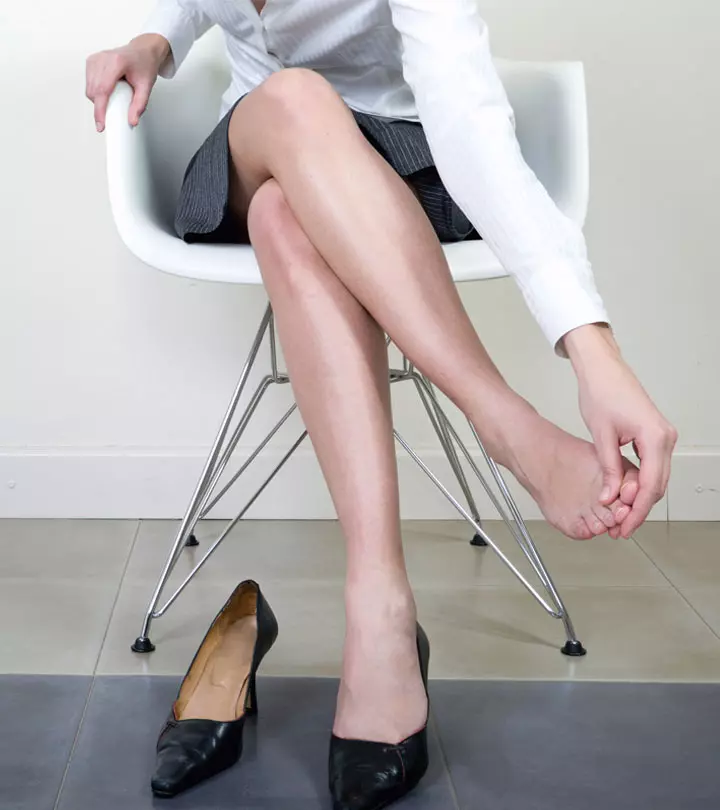












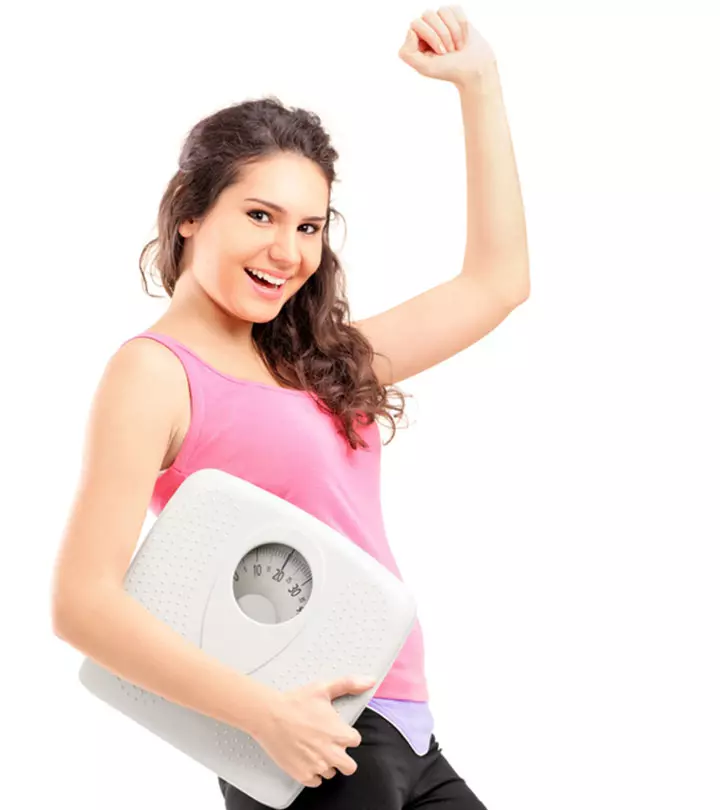



Community Experiences
Join the conversation and become a part of our empowering community! Share your stories, experiences, and insights to connect with other beauty, lifestyle, and health enthusiasts.